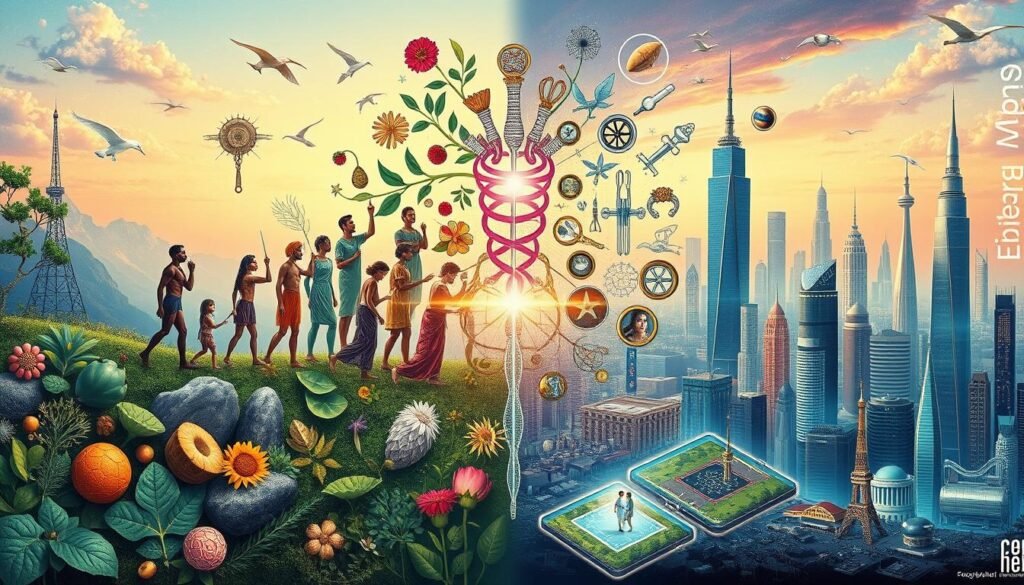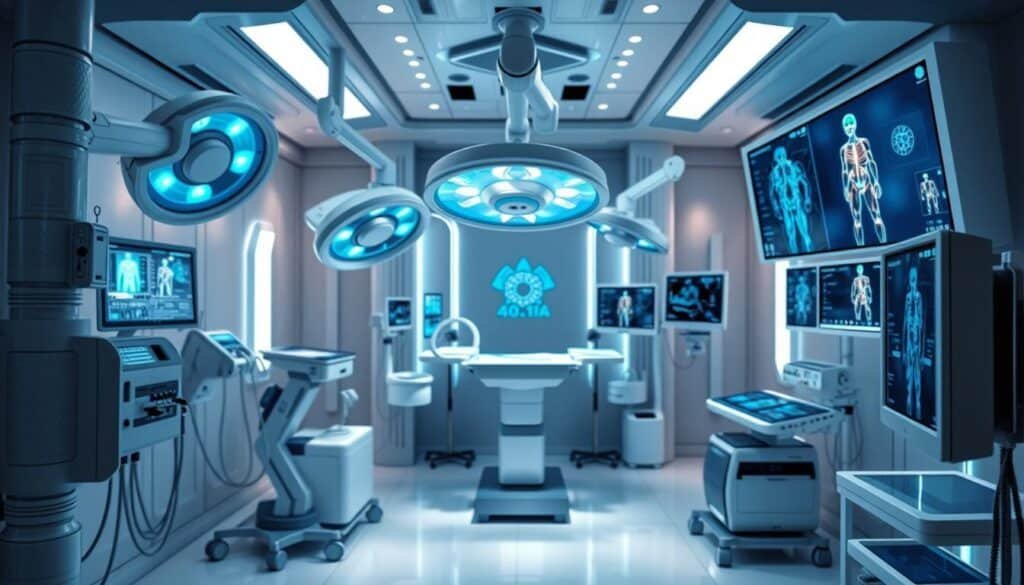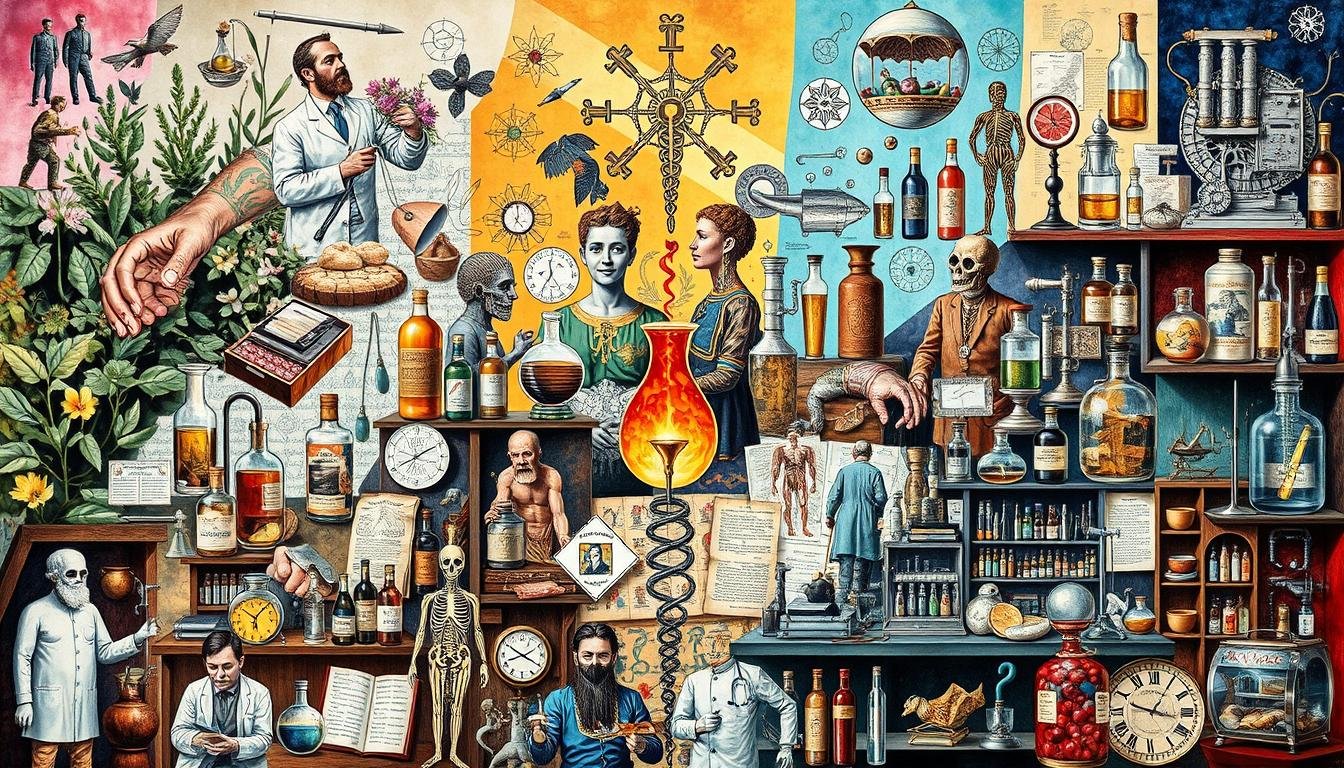Medical science has changed a lot, moving from old healing ways to new, advanced treatments. Over time, doctors and researchers have found new things, made new tools, and explored new ways to help people. This has greatly improved our health and wellbeing.
The journey of medical science has hit many important points. For example, the smallpox vaccine came out in 1799, and the electrocardiograph was invented in 1914. These moments have helped us understand our bodies better and find new ways to fight diseases.
Today, we see big steps forward in stopping diseases and in medical technology. We also see big improvements in surgery and organ transplants. All these changes show how far medical science has come.
Key Takeaways
- Medical science has evolved from ancient healing practices to cutting-edge treatments and technologies.
- Key milestones include the introduction of the smallpox vaccine, the development of anesthesia, and the invention of the electrocardiograph.
- The field has seen revolutionary discoveries in disease prevention and breakthrough innovations in medical technology.
- Significant advancements have been made in surgical techniques and organ transplantation.
- The expansion of medical knowledge has led to the rise of specialized medical fields.
The Foundation of Medical Science Through History
Medical science has deep roots, going back thousands of years. Ancient civilizations started early medical practices and healing methods. These steps led to the scientific method in medicine and our modern understanding of health and disease.
Early Medical Practices and Traditional Healing
Imhotep, from ancient Egypt, lived around 5,000 years ago. He’s seen as one of the first to use science in medicine. He believed in observing, diagnosing, and treating diseases.
The Edwin Smith papyrus is the oldest medical document. It talks about trauma surgery and understanding the body. It’s from around 1600 BCE but based on older texts from 3000 BCE.
The Ebers papyrus also shows ancient Egypt’s medical knowledge. It talks about mental health, gynecology, and surgery. It shows a deep understanding of the human body and diseases.
Development of Scientific Method in Medicine
Hippocrates of Cos lived from 460 BCE to 370 BCE. He made medicine a science, focusing on natural causes of diseases. His Hippocratic Oath is still used today, showing his lasting impact.
Galen, in the Roman Empire, made big contributions to medicine. He built on ancient knowledge, influencing medicine for centuries.
Emergence of Modern Medical Understanding
Alexandria was a center of learning, with over 700,000 scrolls. Its medical school was known for anatomy studies. Physicians like Herophilus and Erasistratus made important discoveries.
Later, Oliver Wendell Holmes found the cause of puerperal fever in 1843. Theobald Smith discovered how insects spread diseases in the late 1800s and early 1900s. These were big steps forward in medicine.
Medical science has grown from ancient remedies to today’s wonders. Scholars and pioneers have shaped our understanding of health. Their work has led to medical science programs, biomedical research, and advances in physiology, biochemistry, and molecular biology.
Revolutionary Discoveries in Disease Prevention

Medical science has made huge strides in stopping diseases. A key breakthrough was the polio vaccine culture technique in 1949 by John Enders, Thomas Weller, and Frederick Robbins. This led to vaccines for many diseases like measles, mumps, and chickenpox.
In cancer treatment, the 1950s were a game-changer. Sidney Farber and his team got the first cancer remissions in kids. This raised the cure rate from 40% to 85%. It shows how important systems, courses offered at medical schools, and coursework in biotechnology and biomedical science are.
Eradicating Smallpox
Smallpox was wiped out, a disease that killed 300-500 million people in the 19th century. Edward Jenner’s smallpox vaccine in the late 18th century helped. The World Health Organization declared it eradicated in 1979.
“Smallpox is the only human disease to have been completely eradicated by vaccination.”
The victory over smallpox shows the strength of medical innovation. It proves that medical systems, courses offered, and coursework in biotechnology and biomedical science can fight even the deadliest diseases.
Breakthrough Innovations in Medical Technology

The field of medical technology has seen huge changes. New inventions have changed healthcare a lot. These include better medical devices, diagnostic tools, and imaging tech.
Invention of Essential Medical Devices
The iron lung was invented in 1927 by Philip Drinker. It helped polio patients breathe. The first implantable cardiac pacemaker came in 1960. It saved many lives by fixing heartbeats.
Evolution of Diagnostic Tools
Diagnostic tools have made big strides. MRI was introduced in 1979 by Mass General researchers. It changed how we see the body. The artificial kidney was made in 1947 and proton beam therapy in 1960.
Impact of Imaging Technologies
Imaging tech is key for finding diseases early and planning treatments. AI has made these tools better. This helps doctors give better care, especially in fighting cancer.
Looking ahead, medical tech will keep getting better. We’ll see more personalized medicine and use of wearable devices and telemedicine. This will make healthcare more precise, efficient, and accessible for everyone.
Medical Science: From Laboratory to Clinical Practice

Medical science has moved from the lab to real-world use, marking a big step forward in healthcare. This shift has brought about major breakthroughs. These have changed how we diagnose, treat, and manage health issues.
One key moment was Dr. Robert Gross’s first successful heart surgery on a child in 1938. This opened up new possibilities for heart surgery in kids. In 1952, Dr. Joseph Murray performed the first kidney transplant on twins. This was a big step for transplant medicine.
The work at the Boston Lying-In Hospital in 1954 was another important step. They started clinical trials for oral contraceptives. This showed how lab work can lead to real healthcare solutions.
Today, the link between labs and clinics is more important than ever. Laboratory results guide 60% to 70% of medical decisions. Labs also account for 10% of healthcare costs, helping improve care and save money.
More tests are needed now, thanks to medical science advances. This means lab staff must keep learning. Automation and changes in lab work have made their jobs different.
| Metric | Value |
|---|---|
| Laboratory results as basis for medical decisions | 60% – 70% |
| Laboratory diagnostics contribution to healthcare costs | Around 10% |
| Increase in panel, quantity, and availability of lab tests | Over the past 20-30 years |
It’s key that lab workers get good training before and after they start. They need to know a lot about lab medicine. This helps them run labs well and give advice on treatments.
Combining research and routine testing is also crucial. It helps make medical decisions better and leads to guidelines based on lab tests.
“60 to 70 percent of all decisions regarding a patient’s diagnosis, treatment, hospital admission, and discharge are based on the results of tests performed by medical laboratory scientists.”
Surgical Advancements and Organ Transplantation

The field of medical science has seen huge leaps in surgery and organ transplants. These changes have greatly improved healthcare. They have led to better patient care and saved many lives.
Pioneering Surgical Techniques
Modern surgery has seen many breakthroughs. In 1923, Eliot Cutler did the first successful heart valve surgery. This opened the door for more complex heart surgeries.
In 1962, Ronald Malt’s team reattached a human limb. This achievement has inspired many advances in surgery and transplant medicine.
Milestones in Transplant Medicine
Organ transplants have changed how we treat serious diseases. The first kidney transplant was in 1952. Since then, heart, liver, and other organ transplants have made great progress.
But, the need for transplants keeps growing. In the USA, the number of people waiting for transplants went from 80,790 in 2002 to over 117,000 in 2012.
Modern Surgical Technologies
New medical technologies have changed surgery a lot. Techniques like normothermic regional perfusion (NRP) and ex vivo organ perfusion have helped more people get transplants. These advances, along with new medical devices and tools, have greatly improved surgery and organ transplants.
| Year | Individuals Waiting for Organ Transplants in the USA |
|---|---|
| 2002 | 80,790 |
| 2007 | 97,670 |
| 2008 | 100,775 |
| 2009 | 105,567 |
| 2010 | 109,375 |
| 2011 | 112,766 |
| 2012 | 117,040 |
As the US population grows, especially the elderly, the need for transplants will rise. The medical and biological science fields are working hard. They aim to improve surgery, organ transplants, and patient care in the field of medical and dental fields.
The Rise of Specialized Medical Fields
The field of medical science has seen a big change. New specialized areas have come up, changing how we care for health. The American Association of Medical Colleges (AAMC) says there are over 135 medical specialties now. Each one needs special skills and a lot of training after college.
Important discoveries have led to these new fields. For example, photochemotherapy was developed in 1974 by Mass General’s Thomas Fitzpatrick and John Parrish. In 1976, C. Ronald Kahn found insulin resistance receptors. These findings have helped create better treatments for many health issues.
Now, students can pick from many medical specialties. Each one has its own education and training needs. For example, allergy and immunology needs at least five years, while anesthesiology and cardiology need four and six years, respectively.
These new fields have brought better research and care for patients. They also offer new chances for students in the medical sciences, like physician assistant programs. This is especially true for international students, who see the chance for advanced research and practice.
Also Read : Understanding Medical Procedures: What To Expect Before, During, And After
FAQs
Q: What is a medical science program?
A: A medical science program is an academic curriculum designed to provide students with foundational knowledge in various aspects of health science, including biomedical sciences, physiology, and biochemistry, typically preparing them for advanced studies or careers in the health professions.
Q: What are the prerequisites to enroll in a graduate medical science program?
A: To enroll in a graduate medical science program, students usually need to complete a bachelor’s degree in a related field, such as biology, health science, or biochemistry. Additionally, some programs may require scores from the Medical College Admission Test (MCAT).
Q: What can I expect to learn in a master of science in medical program?
A: In a master of science in medical program, students will explore advanced topics in areas such as molecular biology, cell biology, and physiology. The curriculum often includes both theoretical courses and hands-on laboratory experiences to prepare students for careers in medical research or clinical settings.
Q: Are there specific courses offered in the MS in medical sciences?
A: Yes, an MS in medical sciences typically includes courses in basic science disciplines such as biochemistry, molecular biology, and health science, as well as specialized courses related to medical systems and research methodologies relevant to the medical field.
Q: How does a degree in medical sciences differ from a degree in health science?
A: A degree in medical sciences often focuses more on the scientific and research aspects of medicine, including rigorous coursework in areas like physiology and biochemistry, while a degree in health science may emphasize public health, health policy, and community health initiatives.
Q: What career options are available for graduates of a medical science program?
A: Graduates of a medical science program can pursue various career paths, including roles in medical research, clinical laboratories, pharmaceutical companies, and academic institutions. Some may also continue their education in professional schools for medical or dental degrees.
Q: Is it necessary to complete a medical or dental degree after earning a degree in medical sciences?
A: While it is not necessary to pursue a medical or dental degree after earning a degree in medical sciences, many graduates choose to do so to advance their careers in healthcare. The medical sciences degree can serve as a strong foundation for further studies in professional school.
Q: What is the importance of the Medical College Admission Test (MCAT) for students in a medical science program?
A: The MCAT is crucial for students aspiring to enter professional schools, such as medical or dental schools. High scores on the MCAT can enhance a student’s application and demonstrate their readiness for the rigorous coursework required in these programs.
Q: Can students in a medical science program participate in research opportunities?
A: Yes, many medical science programs encourage students to engage in research opportunities, often allowing them to work alongside faculty members in laboratories. This hands-on experience is invaluable for those considering a career in biomedical research or advanced academic studies.








